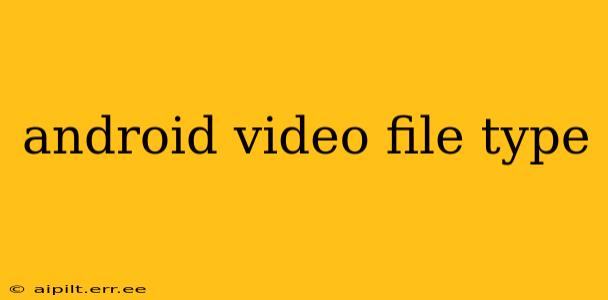Android devices support a wide range of video file types, ensuring compatibility with various sources and applications. Understanding these formats is crucial for seamless playback and efficient file management. This guide dives into the most common Android video file types, addressing frequently asked questions and offering insights into choosing the best format for your needs.
What are the most common video file types on Android?
Android's versatility shines through its compatibility with numerous video formats. The most prevalent include:
-
MP4 (MPEG-4 Part 14): This is arguably the king of video formats for Android. Its widespread support, efficient compression, and ability to hold both video and audio streams make it the ideal choice for most situations. Variations within MP4 exist, often impacting codec choices (more on that below).
-
MOV (QuickTime File Format): While historically associated with Apple, many Android devices now support MOV files, particularly those using the H.264 codec. However, compatibility isn't universally guaranteed.
-
3GP: This older format was designed specifically for mobile devices and offers smaller file sizes, but its capabilities are limited compared to more modern options like MP4. You'll likely encounter it less frequently these days.
-
MKV (Matroska Video): An increasingly popular choice known for its flexibility and support for multiple audio and subtitle tracks within a single container. Its open-source nature makes it attractive, but older Android devices might struggle with compatibility.
-
AVI (Audio Video Interleave): A legacy format with varying degrees of Android support. Its age means that modern codecs are often absent, leading to playback issues.
What video codecs are compatible with Android?
The container format (like MP4 or MOV) holds the video data, but the codec is the actual method of compressing and decompressing that data. Common Android-compatible codecs include:
-
H.264 (AVC): A highly efficient and widely supported codec, often found in MP4 and MOV files. It provides a good balance between quality and file size.
-
H.265 (HEVC): More efficient than H.264, offering better compression at the same quality level or higher quality at the same file size. However, it requires more processing power, potentially affecting older devices.
-
VP8/VP9: These open-source codecs, often used in WebM containers, are gaining popularity due to their efficiency and royalty-free nature.
-
MPEG-4 Part 2: An older codec, less efficient than modern alternatives. You're less likely to see it in newer videos.
Which video file types are best for Android?
For optimal compatibility and performance across most Android devices, MP4 with H.264 or H.265 encoding is the recommended choice. These offer a great balance of quality, file size, and broad support. While MKV offers flexibility, its compatibility might not be as consistent across all devices.
How can I convert video files to Android-compatible formats?
Numerous free and paid software applications and online converters are available to convert videos to Android-compatible formats. Simply search for "video converter" on your preferred search engine; many provide the functionality to select your desired output format and codec.
Can all Android devices play all video file types?
No. While Android's support for various file types is extensive, compatibility depends on several factors, including the device's hardware capabilities, installed software (like a dedicated video player app), and the Android version. Older devices are less likely to support newer codecs like H.265.
What are the advantages and disadvantages of different video file types?
| File Type | Advantages | Disadvantages |
|---|---|---|
| MP4 | Wide support, efficient compression | Can be large depending on codec and quality |
| MOV | Good quality, often uses efficient codecs | Compatibility can vary |
| 3GP | Small file size | Limited quality and features |
| MKV | Flexible, multiple audio/subtitle tracks | Compatibility can vary, potentially resource-intensive |
| AVI | Legacy format, familiar to many | Limited codec support, often inefficient |
By understanding these factors, you can ensure seamless playback and efficient management of your video files on your Android device. Remember that always checking the specifications of your specific device and player app will always offer the best results.
